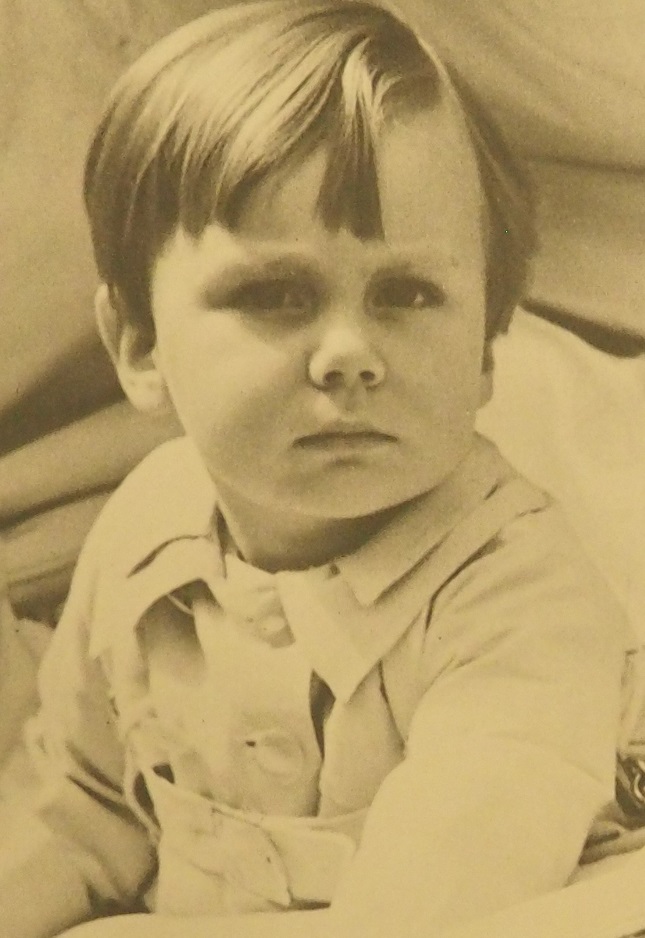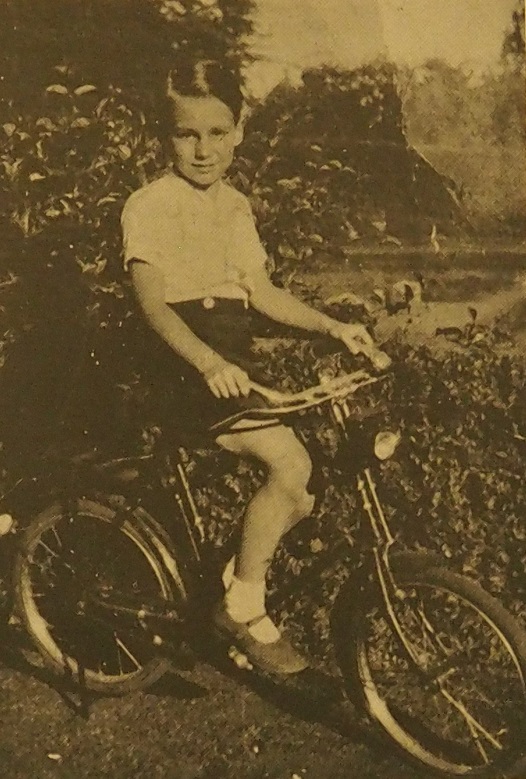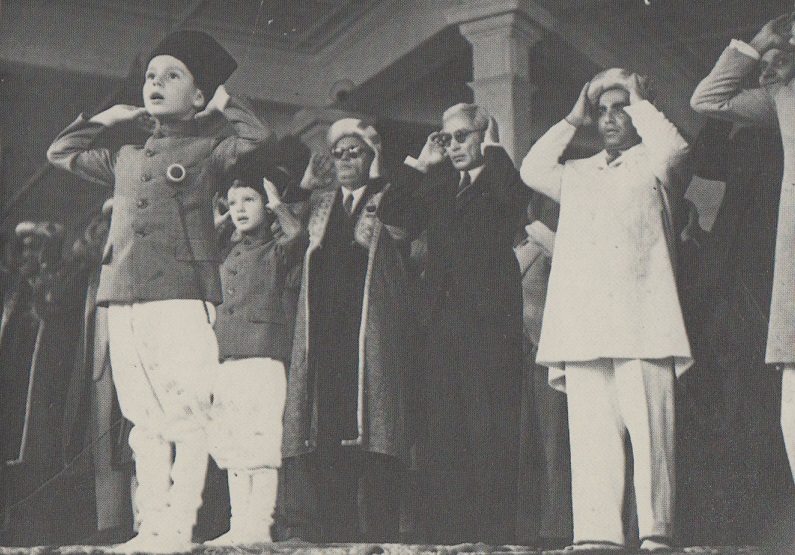FROM THE DIARY OF LATE KADERALI B. PATEL
(RELIGIOUS TUTOR OF PRINCE KARIM AGA KHAN AND PRINCE AMYN AGA KHAN)

Mawlana Sultan Mahomed Shah, His Highness the Aga Khan III, 48th Ismaili Imam, with his grandsons Prince Amyn (right) and Prince Karim, who succeeded him in 1957 as the 49th Hereditary Ismaili Imam. The picture was taken in Nairobi, Kenya, in 1942. Photo: 25 Years in Pictures. Islamic Publications, London, UK, Volume 1.
His Highness the Aga Khan III (1877-1957), who became the 48th Imam of Ismaili Muslims in 1885 at the age of 7, was in the 51st year of his reign when his first grandson, Prince Karim, was born on December 13, 1936 in Geneva. Destined to become the 49th Imam some 20 years later in 1957, Prince Karim spent his early childhood in Kenya with his younger brother Prince Amyn during the Second World War.
The three heartwarming stories, below, were recorded in Gujarati in a diary kept by Kaderali B. Patel, who was responsible for imparting religious training to Prince Karim and Prince Amyn while they were in Kenya. The stories are adapted from Farida S. Kassam’s English translation that appeared in a special edition of “Africa Ismaili,” published in July 1982 to mark the Silver Jubilee of Mawlana Hazar Imam, His Highness Prince Karim Aga Khan.

A very early portrait photo of Prince Karim Aga Khan. Photo: 25 Years in Pictures. Islamic Publications, London, UK, Volume 1.

Prince Karim Aga Khan on a rocking horse. Photo: Africa Ismaili, July 1982.
The Aga Khan on his “toto” days in Kenya
“When I speak of places that have played a major role in my life, no place comes to mind more quickly than Kenya. My ties here go back to my “toto” days – how can I ever forget our childhood house on Caledonian Road, now named the Denis Pritt road and the mega rhubarb I grew up the rain-water drain, or driving down the garden steps in the late Sir Eboo’s car? And how could I forget my brother’s despair when his pet bantam chickens were eaten one night by a visiting leopard? Little did I suspect that the next night my rabbits would suffer the same fate.” — Aga Khan, State banquet, Nairobi, August 13, 2007.

A charming portrait of Prince Karim Aga Khan in a volunteer uniform when he was nine years old. Photo: Africa Ismaili, July 1982.

Prince Karim Aga Khan on his bicycle. Photo: Africa Ismaili. July 1982.
~~~~~~~~~~~~~~~~~~~~~
STORY #1: WORK BUILDS THE BODY: CHOPPING WOOD, GROWING CROPS AND CARING FOR THEM
“Just as we need food and water, so do the plants. Near our vegetable garden there are many large trees. The wind blows many leaves onto our crops. Young plants would get buried under the weight of these leaves, so every morning both of us collect all the leaves and burn them.” — Prince Karim

Prince Karim (top) and Prince Amyn at play on a tree. Photo: Africa Ismaili, July 1982.
One morning, sitting on the ground, Prince Karim was chopping some wood with his axe. Rather astonished to find him thus occupied, I told him: “Prince Karim, you will hurt your hands with the axe because it is very sharp. If you asked the gardeners, they would chop the wood for you.”
Smiling, Prince Karim answered: “You are right, my axe is very sharp; but I am chopping the wood very carefully. I exercise my arms doing this job. Those people who do not exercise, do not work and are lazy, soon become weak.”
“In the evening, my brother and I will hoe the ground and plant some grain. Then we shall fetch water from the tap and water our crop. Small plants will soon grow from the seeds. Look, all these carrots, potatoes, tomatoes, cabbages, etc., have been planted by us. There are some maize plants too. Soon we shall grow some flowers. We very much like to work in this way.”

Princes Karim and Amyn measure the drop from a car bumper. Photo: Africa Ismaili, July 1982.
Prince Amyn was standing nearby and I asked him which was his crop. He took my hand and led me to his section. “Here, these are carrots, beetroot, and a grain crop as well,” he said happily.
“Work hard. No doubt we must work hard. If we did not look after our cultivation and if we did not water the plants, how would the plants grow?”
Prince Karim added: “Just as we need food and water, so do the plants. Near our vegetable garden there are many large trees. The wind blows many leaves onto our crops. Young plants would get buried under the weight of these leaves, so every morning both of us collect all the leaves and burn them.”
The Princes looked after their plantation with keen interest. I have seen them doing different jobs regularly. “Work builds the body,” was Prince Karim’s motto, which I will never forgot.
STORY #2: EXCELLING IN SECULAR AND RELIGIOUS EDUCATION
“The programme of religious instruction lasted an hour daily. The Princes enjoyed and listened attentively to the short stories of the Holy Prophets and Ismaili Pirs. They would never show any reluctance in saying their Namaz.” — Diary
 Prince Karim (holding flag) and Prince Amyn with the Mombasa Aga Khan Scouts Band. Photo: Africa Ismaili, July 1982.
Prince Karim (holding flag) and Prince Amyn with the Mombasa Aga Khan Scouts Band. Photo: Africa Ismaili, July 1982.
Prince Karim and Prince Amyn always did their lessons. Their governess, Miss Lyon, paid great attention to their education. She taught them English, maths, writing and art with great care.
The Princes loved to colour pictures of animals and birds. They collected large and small pictures and carefully stuck them into an album.
When Prince Aly Khan and Princess Tajudaulah visited them in Nairobi, both the Princes would show them their albums.
Every morning the Princes came to their study-room to learn Namaz. The moment they entered the study room they greeted me with ‘As-salam-alaikum’ [Peace be unto you] and, standing up, with arms folded, l returned their greeting with ‘Wa-alaikum-salaam [And unto you, peace]. The programme of religious instruction lasted an hour daily. The Princes enjoyed and listened attentively to the short stories of the Holy Prophets and Ismaili Pirs.
Prince Karim and Prince Amyn would never show any reluctance in saying their Namaz. Whatever lesson was taught to them, they made a great effort to remember it and next day repeated it, trying to excel each other. They did not like to make mistakes. They were only satisfied when they were sure they had learnt the subject thoroughly and could answer questions without hesitation. They never became irritated.
As soon as the hour for lessons was over, Prince Karim and Prince Amyn would take me to their garden and tell me all about their cultivation.
“We have planted many different flowers along the paths. When all the flowers bloom, the paths will change their colour and we shall be very pleased,” they said.
As we were talking, we were joined by Miss Lyon. The Princes told her about their various plants and showed them to her.
As it was hot, Miss Lyon told the Princes to go and put on their hats. They ran into the bungalow, put on their hats and rode off on their bicycles to play tennis.
STORY #3: RECITATION OF IDD NAMAZ AT AGE 7, AND REPEATED IDD MUBARAK HAND SHAKES
“There were many children who attended the Idd Namaz. Most of these children came to wish us Idd Mubarak and shake hands with us. Among these children were some who shook hands with us and then, greatly excited, came back for a second handshake.” — Prince Amyn

Prince Karim Aga Khan leading the Idd ul Ftir prayers in Nairobi in 1944. Photo: 25 Years in Pictures. Islamic Publications, London, UK, Volume 1.
Prince Karim first recited the Idd Namaz in public in his childhood, at the age of seven, at Nairobi Chief Jamatkhana. It had been announced in the Jamatkhana the previous day that Prince Karim would lead the Idd Namaz at 10 a.m. All Ismailis were delighted when they heard the announcement.
Next day was Idd-ul Fitr. Early in the morning all Ismailis arrived dressed up in their best clothes. The officers all wore golden red gowns. This was a very unique occasion and everyone’s heart was filled with inner happiness.
At 10 a.m, Prince Karim arrived at the Main Jamatkhana on Government Road with his brother Prince Amyn. The Jamat’s chief officers welcomed the Princes.
Prince Karim took his place in front of the Jamat and recited the Namaz. Then Prince Karim and Prince Amyn stood in line with the officers and for hours shook hands with Ismaili brethren and wished them ‘Idd Mubarak’.
They gladdened the hearts of thousands of people who will never forget the ‘Idd Mubarak’ uttered by Prince Karim.

A portrait of Prince Karim Aga Khan in a volunteer uniform when he was nine years old. Photo: Diamond Jubilee Souvenir, 1946, published by the Ismailia Association of Africa. The magazine was acquired from Sadruddin Khimani Family Collection, Vancouver, Canada.
In the evening, when I went to see the Princes at their bungalow, I found them talking to Miss Lyon on the verandah. I went nearer and greeted them with a salaam. Prince Karim asked me to come closer. I respectfully bowed before him and said: “You must be tired, standing for hours and shaking hands with so many people.”
Prince Karim replied, smiling: “We are not at all tired. In fact we are very pleased that on this holy occasion we were able to meet and shake hands with all Ismailis, young and old alike. Indeed, we are very happy.”
I asked Prince Amyn if he was tired. He replied: “Not at all. There were many children who attended the Idd Namaz. Most of these children came to wish us Idd Mubarak and shake hands with us. Among these children were some who shook hands with us and then, greatly excited, came back for a second handshake. Even though we knew this, we shook hands with them again. We were pleased to make them happy.”
I said: ‘You are right when you say some children came twice to shake hands with you. As this was their first occasion to shake hands with you, they were tremendously happy.’
I asked Prince Amyn if he would offer the Idd Namaz the following year. He replied: “I cannot promise you that. It depends on what my parents have to say. It is every child’s duty to obey his parents.”
Prince Karim added to this: “That’s true. We must obey our parents. God is not pleased with those children who do not listen to their parents.”
It seemed that flowers poured out of the Princes’ mouths when they said these words.
Prince Karim and Prince Amyn were extremely happy on that auspicious day.
Date posted: March 29, 2017.
Last updated: March 29, 2017, 21:21 EST.
________________
For links to all the posts in this special project on His Highness the Aga Khan, please see the drop down menu bar at top of this page or click on Table of Contents. Also join/like Barakah’s faceboook page http://www.facebook.com/1000fold.
Barakah welcomes your feedback. Please complete the LEAVE A REPLY form below or send your comment to simerg@aol.com. Your letter may be edited for length and brevity, and is subject to moderation. You may choose to remain anonymous. Please note that we never show your email address when we publish your comment, and don’t share it with others without your express written permission.
Mawla bless you for sharing these wonderful pictures and stories of Hazar Imam’s and Prince Amin Mohamed’s childhood. Ameen
LikeLike
I have had the honor of visiting both princes in Nairobi frequently on many occasions and possess a photograph taken on the stairs. I was of the same age, two years older, than Prince Karim and spent considerable time with them in their playgrounds. They were very happy in Nairobi. Missionary i.e. al waez Kadarali was a very close family friend and talked about them. I distinctly remember the Namaz and the long queue to wish them Idd Mubarak. I believe young child standing near the right pillar is me!
LikeLike
Wow!! Beautifully written.Thanks so much for sharing.
LikeLike
Beautiful photos and stories! Thank you for sharing and may Mawla bless you.
LikeLike
Very good photos and lots of wonderful memories of Count Fatehali’s residence. I have seen them at the residence long time ago; Countess Roshan had shown them to me.
Thank you
Sadru Jamal of Mombasa (aka Sadru Badar)
Mombasa, Kenya.
LikeLike
Very good information. Keep it up. With regard to the group band photo, my father was present there as a flute player.
Thank you.
Sadru Jamal (known as Mukhi Badar in Mombasa).
LikeLike
Thanks for sharing Noorani family wonderful childhood events
LikeLike
Thank you for sharing these wonderful stories. It is amazing what we learn about ethics and values from our Imam’s childhood.
LikeLike
Thank you for sharing these stories. Kaderali Missionary is my maternal grand father. My mom and aunt have all these treasures in their hearts. Blessed to be his grand daughter. Thank you.
Parin Sidi
Toronto
LikeLike
Thanks for the nice childhood stories of our beloved Hazar Imam. They are great examples to all of us of the duties and responsibilities we have to our parents, that we should be hardworking, excel in both secular and religious education as well as care for everything around us – the flowers and the plants and the trees.
LikeLike
Thanks for sharing wonderful stories.
LikeLike
Thank you for sharing such a wonderful Life story of our beloved Mawlana Hazar Imam and Prince Amin when really they were totos!
LikeLike
Good the diary was not lost and it was translated in English so we could all enjoy those stories. We can treat this as a part of Ismaili heritage.
LikeLike
Very interesting stories and beautiful pictures.
LikeLike
Very nicely done. Thank you very much.
LikeLike
Thank you and may God bless you for sharing these really wonderful photos and stories.
LikeLike
Right from such tender age till date Mowla Bapa has always graced us with wonderful lessons. We truly are blessed.
LikeLike
Most wonderful moments that must have been for the Jamat at that time🙏🏽
LikeLike
So very beautiful! Mawlana Hazar Imam and Prince Amyn so virtuous and disciplined even at that age. We have so much to learn. Thanks for sharing such beautiful memories!
LikeLike
Lovely stories much enjoyed. What about stories of their visit to Mombasa where they stayed at Count Fatehali Dhala’s residence with Mrs Lyon for 3 months and missionary Saheb accompanied them? There are many photos of them enjoying the beaches and young Ismaili volunteers band. It would be great to hear their stories .
LikeLike
Thanks for sharing these precious stories.
LikeLike
Wonderful article. Thank you.
LikeLike
Thanks for these beautiful pictures.
LikeLike
Beautiful. Words of wisdom poured out of our Imam and brother at such young ages.
LikeLike
These stories are so beautiful! Thanks for sharing.
LikeLike
I am honored to get a glimpse into Mawla Bapa’s childhood. Shukhar Mawla. Thank you so much for publishing this piece. Looking forward to reading some more such stories.
LikeLike
Wonderful! Thanks for sharing these beautiful stories.
LikeLike
Thank you for publishing the translation. I wonder whether other diary note of Kaderali B Patel are available and whether they have been published elsewhere. I assume they would be in Gujarati, as these stories were. Hope to read more such wonderful stories.
LikeLike
Beautiful stories worth sharing. Thank you.
LikeLike
Thank you for sharing amazing beautiful stories of Mawlana Shah Karim and Prince Amyn.
Dill baag baag hogaya.
LikeLike
Wow, this is remarkable and beautiful – thank you so much for sharing this treasure!
LikeLike
Thank you for sharing such precious moments.
LikeLike
Thanks for sharing with us. That was beautiful.
LikeLike
So beautiful – made me cry. God bless!
LikeLike
Thank you. That’s beautiful.
LikeLike
Wow! Thank you so much for sharing.
LikeLike
Beautifully written. I will forward it to REC teachers of primary grade students.
LikeLike
Wonderful stories. Thank you.
LikeLike
Please accept my thanks and congratulations on this wonderful Photo Essay.
Muslim Harji
Montreal.
LikeLike